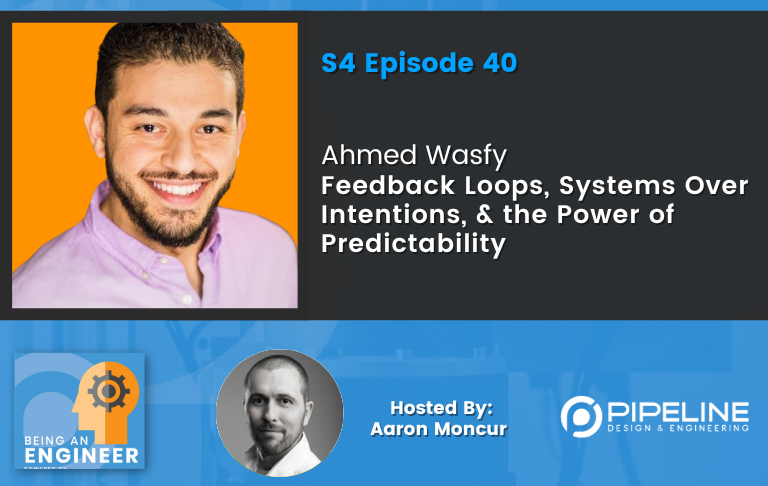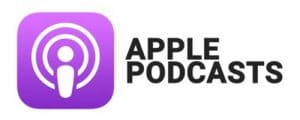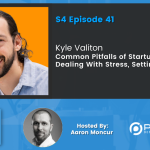S4E38 Ahmed Wasfy | Feedback Loops, Systems Over Intentions, & the Power of Predictability

Who is Ahmed Wasfy?
Ahmed Wasfy holds a master of applied science degree in electrical and computer engineering. He has worked as a senior engineer and engineering manager at software giants Microsoft, Amazon, and Google. In addition to his current role at Amazon, he also coaches engineers on how to become great tech leaders through a structured framework he has pieced together during his own years in leadership.
https://www.thethrivingem.com/home
EXPAND TO VIEW EPISODE TRANSCRIPTION
SUMMARY KEYWORDS
engineers, project, people, week, managing, leader, team, estimates, day, call, email, number, system, block, learn, helps, senior engineer, calendar, couple, software
SPEAKERS
Aaron Moncur, Ahmed Wasfy
Ahmed Wasfy 00:00
Hi everyone, we’ve set up this being an engineer podcast as an industry knowledge repository, if you will, we hope it’ll be a tool where engineers can learn about and connect with other companies, technologies, people, resources and opportunities. So make some connections and enjoy the show. Emails are mostly other people’s priorities. And I never start my day by reading email. It’s all about protecting your most creative time.
Aaron Moncur 00:43
Hello, and welcome to the being an engineer Podcast. Today, we have the privilege to speak with Ahmed Wasfy, who holds a Master of Applied Science degree in both electrical and computer engineering. Ahmed has worked as a senior engineer and engineering manager at software giants, Microsoft, Amazon and Google. In addition to his current role at Amazon, he also coaches engineers on how to become great tech leaders through a structured framework he has pieced together during his own ears, and leadership. Ahmed, welcome to the show.
Ahmed Wasfy 01:15
Thanks for having me. Excited to be here.
Aaron Moncur 01:18
All right, well, what made you decide to become an engineer?
Ahmed Wasfy 01:21
Oh, good question. I think like a lot of engineers, especially building the software field, he was really the, you know, wanting to create things myself, in perhaps with the world of software, you can see the results a little bit quicker, which gets you more excited as you were a kid. And that kind of, you know, it really kind of fueled by passion for, you know, for the profession.
Aaron Moncur 01:46
Yeah, it’s funny that word creation pops up a lot. And as you were saying that I was thinking, yeah, software, you get to see things a lot quicker. And then I also realized, well, software has actually helped mechanical engineering, because we have CAD now. And you do get to see things pretty quickly when you’re doing CAD. Thanks to software. So thank you, all of you, software engineers out there who have made the Emmys job even more enjoyable. Well, how did you get into leadership?
Ahmed Wasfy 02:12
Good question. So I think the, one of the you know, one of the lenses where I’d like to think about that is, oftentimes when you look back at significant sort of moments or changes or milestones in your life in your career, you could start to notice some patterns and extract the kind of the, the core values that you care about from those, and that can sometimes help inform, you know, your future direction. So, when I did a similar exercise at a time, when I was considering kind of, you know, getting going into leadership, officially, I noticed a couple of themes pop up, and they were really around learning and impact. On the learning side, a lot of my moves were were fueled by learning, I wanted to learn about a new kind of industry or a new technology space. And that informed several of my earlier career pivots, or career changes, rather. And on the impact side, I’ve, as I’ve grown to become a senior engineer, I could see my you know, the impact of my work AMPLIFi, I remember, when I kind of decided to make that transition, I was I was at Microsoft at the time, I was a senior engineer on the OneNote. Team, it’s a note taking app, part of Office 365. And at the time, I wanted to modernize offices, entire kind of web development, stack. And we were able to achieve it, but I was lucky enough to be a senior engineer back then, and, and could influence a number of engineers to help me achieve that. And I got me thinking, wow, the the impact that could have here, you can just multiply beyond myself, if I continue down this kind of, you know, leadership path. And then on the learning front, believe it or not, technical challenges were getting kind of repetitive for me at that point. Because, you know, there’s very well structured kind of, you know, patterns and templates for doing things. And once you’ve done it a few times, it tends to be more boring if you’re not doing you know, the real cutting edge work. But people were a complete black box to me back then. And you know, it’s not like a computer where you program it and it does what you tell it to do. So that was one another one that actually influenced me to get into shipping, you know, to learn more about people and dive more into you know, that mysterious world
Aaron Moncur 04:43
A new challenge. Yeah, exactly. Excellent. Well, you’ve been working with people for for quite a while now as a leader and as you talked about patterns, as you have worked with these different engineers over the years, what what patterns have you seen or what are some of the common problematic patterns that you see new engineering leaders fall into? And how can they avoid those?
Ahmed Wasfy 04:45
Yeah, no, there’s, there’s quite a few, I think the some of the ones that I think every new manager at work with definitely experiences. The first one is around feedback loops. So we talked earlier about, you know, software and even, you know, things like CAD helping you see the results a lot quicker. And so as a, as an individual contributor, your feedback loop is really short, he could write some code, he could run it, he could see the output of your work, sometimes you can even push it to production and get metrics about how people are using it in the real world. So you got, you know, the feedback loop really quickly, and you know, exactly what’s going on, as a leader. Most of the, you know, big results that you’re trying to do, you’re trying to grow individuals, you’re trying to deliver larger projects, where there isn’t really a very quick feedback cycle, these things take months and years to, you know, to bear fruit. And sometimes, in new leaders, especially, it’s very hard for them to gauge whether or not they’re, you know, they’re going on, you know, in the right direction, are they doing the right thing, and it can be a challenge to kind of work in a longer timescale or time horizon. And, you know, some of the ways to mitigate that is essentially try to find quicker indicators of progress. Along your journey, I’ll give you a very simple example to to drive a point home. Most leaders have weekly one on ones with with individuals on their team. A quick way, you know, I like to do a pulse check is a ask a happiness reading question. At the end of my one on one, well be like rate your happiness on a scale of one to 10. And engineers like to think, Alright, you know, like to quantify kind of things all the time. So So I find that engineers love that, but also gives you interesting avenues for, you know, for discussions and take, you know, take questions in either direction, like if it’s, if it’s a nine, you know, cutaways not an eight, or if it’s a seven, why is it so low, you know, you were just a nine a couple of weeks ago. So you could often find problems, either in terms of work environment, or maybe even outside of work, and you can help kind of mitigate some of that for for individuals.
Aaron Moncur 07:27
Oh, I like that a lot. I like the scale. Yeah. Engineers do love numbers, we we ask a similar question in our one on ones, we just ask, do you still feel happy working here? But I like the addition of the scale, right? On a scale of one to 10? How happy Do you feel? That’s great, because it exactly can see trends and patterns over time.
Ahmed Wasfy 07:46
Exactly. I actually, I graphed that, and a, it’s Yeah, often see it at a team level with big sort of like rewards or big changes, you could see a drop sometimes, and as a leader helps you sometimes kind of, you know, get ahead of some some of the bigger concerns.
Aaron Moncur 08:00
Interesting, very close.
Ahmed Wasfy 08:03
But But yeah, so that’s one feedback loops. And another, you know, kind of common pattern new leaders fall into is the, the fail to recognize the physic completely new job requiring a completely new set of skills, it’s often easier to default and what we know, you know, default back to your technical kind of skills, or you know, your strong technically, so you, you kind of shy away in that in that corner, and try to still be the technical expert in the SME and on your team, when now it’s not your job anymore, it’s you got to let your actual individual contributors who actually do need shine. And, and not just that, but also invest in that skill gap, right, like learn all the soft skills that you need to become a more effective leader, you know, everything from communicating effectively to negotiating with partners to, to coaching your team to managing up. So that that shift takes takes a while. But it’s a very, very important one that every leader has, has to make as the you know, as the scale. And, and yeah, and then maybe the, you know, the third and final one is easier to think in terms of three than you’ll notice that theme a lot, hopefully through other chat today. But the third one is not relying on good intentions, but but actually establishing sort of, I call them habits but some people call them you know, processes or systems or mechanisms to make sure the right things get done. It’s very easy to you know, Gather your team be like, Hey, guys, we’re not you know, we’re not going fast enough. You got to try harder and everyone is like yeah, and everyone has good intentions, like everyone wants to do better and improve things. But without a process of a system in place, nothing actually gets done. And it’s on you as a leader to to develop that. So kind of instead of being a victim and you know, blaming everything else that’s going wrong around you on that in establish those those mechanisms um And as you know, as you continue in our chat today, we can dive into some examples as we get more specific into into different areas and things.
Aaron Moncur 10:08
Yeah, I’m a big believer in systems and processes. And one of my processes, I think, sometimes when people hear like systems or processes, they think he’s really complicated, convoluted things. And then like, I don’t even know how to start thinking about that. It’s like, it’s gonna be this big thing. And all this work systems can be super easy, super simple. One of my favorite systems is at the beginning of the week, I calendar, everything I put in calendar events for what I’m going to do on each day, takes like, you know, maybe 20 minutes or 30 minutes, it’s really easy. But that’s a system and it’s a great system that’s worked well, for me.
Ahmed Wasfy 10:44
That’s fantastic system. And when I follow it to this day, I will. One thing I often like to add as well, as you know, it doesn’t matter where you start, you can start with any system. One thing that makes this system really, really powerful is what I call it reflection habit, or, you know, having to close that feedback loop. Basically, at the end of the week, I do the same exercise that I did at the start of the week, where I look back and be like, cool. Those were my top priorities. This is what I said, I wanted to get done, what happened? And then how can I be 1% Better next week, and kind of reflecting back on any kind of system you put in place helps you iterate and improve it over time?
Aaron Moncur 11:20
Yeah, that’s terrific. Well, you have speaking of systems, a framework that you use to to manage stress, increase the effectiveness and help leaders thrive. There’s your category of threes there again, will you walk us through that framework?
Ahmed Wasfy 11:35
Sure, yeah, I’ll give you the high level and, you know, I’ll talk about it in again, it’s like I said, you know, system with threes, I’ll talk about some, some of the principles I have for each. So I have, you know, three main pillars to be an effective leader. I call them managing yourself, managing your people, and managing your projects. I’ll talk about some of the principles in each and, you know, I were in my coaching practice, and, you know, I work with individuals who actually implement, you know, it’s, you know, things that you could do concretely to actually drive some of these points. But but, you know, big picture high level, it’s, the way I like to conceptualize this is very similar, you know, it’s a system. And each of those three pillars, there are some principles that you want to do, and ways to measure if you’re doing the right thing or not, and then reflection built in, where you basically look back and be like, cool, what happened, how can we improve and you keep iterating iterating and improving across all those three. So let’s jump in the first one, managing yourself, right, because it all starts with you, if especially as a new leader, you’ll have more demands on your time than ever before. And if you don’t have an effective system to managing your own time, your calendar, your inbox, which which tends to be messy and crazy, and more importantly, the work that you have to do. And sometimes that can mean you doing the actual work or you delegating and following up and holding individual people accountable on finishing that way. So you need that system in place and some of the principles there, you know, start with protecting your time pay yourself first timewise make sure you know just like your example where you look at your calendar at the start of the week and walk time off for the things that need to happen make sure you do that. Managing Your energy is actually a very, very critical component of that it’s not just about time management but for example it’s it’s easier to have a block of one on one meetings than the same chunk of time you know where your context switching between one on ones and you know, project updates and operational reviews and that is way more taxing in your energy so managing you know managing your your energy efficiently throughout the week as well can be a big part of that. And then you know, I mentioned kind of having a system to manage the work so you need a way to be able to sort of have an intake process for the things that you need to make sure you get done you need a way to prioritize them regularly and a way to kind of follow up on any any of the work that you’ve delegated so so you make sure as you get you know gets done and then the next principle is no take breaks new lead especially make this mistake a lot will be booked kind of back to back to back through lunch to everything and they just by the end of the day, you’re you know as as your blood sugar levels drop, you take worse or worse decisions. And long term is not good for your kind of overall efficiency as a leader in general. So I actually you know, I block time for lunch, I block time for my coffee breaks and you know, throughout the week as well. Because you need you need that time. I’m
Aaron Moncur 14:58
sorry, I can interrupt really quickly. I thought it was really interesting that you talked about managing your energy levels, because that’s not something I hear people talk about a lot. And I think it’s super important. So scheduling breaks, that’s one way to do it. Are there other things that you have done to manage your energy? batching? Like activity? That was another one you talked about?
Ahmed Wasfy 15:18
Right? Yeah. Honestly, those are probably the biggest two ones, you know, scheduling breaks batching, like activities, I’ve noticed that everyone has a slightly different threshold, I’ve noticed I can do more than four, one on ones back to back effectively, if I have, you know, more than four, I, I’m grumpy, I’m not very effective. There’ll be different for everyone. Some individuals, you know, why have more capacity might have less capacity for it. So that’s where kind of, you know, monitoring and kind of reflecting in the end of, you know, the week comes in where you’d be like, cool. On Wednesday, I was actually really annoyed and grumpy, why is that, oh, I’ve had, you know, a six hour block of meetings. Cool, let’s break that up, let’s figure out what’s going on here. So that that definitely comes into play, the breaks helped a lot. Because you need, you need food, you know, food, water. Outside of the actual kind of, you know, nine to five, you actually work calendar, you know, the big three, covering no sleep, I call them the, you know, fun, these are fundamentals, you know, sleep, exercise, or movement, and nutrition, right, like those need to be more or less, you know, dialed in seven to eight hours of sleep, that starts the night before, you know, have a go to bed alarm, it’s a bit of a wake up alarm, pump, you know, nutrition, there’s a lot of kind of, kind of different takes on nutrition, but in general, eat kind of, you know, mostly organic foods, mostly plants, don’t eat too much. And, you know, make sure you have sufficient protein to the different kinds of, you know, mix in there. And then movement, even if it’s as simple as, you know, a 30 minute kind of walk every day, or these, you know, if you don’t have the time to do a seven minute workout, you know, but just make sure your body is active and moving. Those are sort of like fundamentals, before you actually get to the actual day to day management of your calendar and
Aaron Moncur 17:10
such. I want to continue to talk about this a little bit more, because this is something that I’m working on right now, personally, is energy levels. And I’ve, I’ve, I get really good sleep consistently. That’s not a problem. I exercise six days a week, pretty intensely, that’s not a problem, either. But food food was always my Achilles heel. You know, I just, I love pizza, and cheeseburgers and Philly cheesesteak sandwiches, right? Like all these delicious foods that are not necessarily great for you or your energy levels. And I realized that I was getting sick a lot. You know, like, in the past year, I’ve gotten sick, a pretty severe cold or flu, like four times, which is just so much, right. And so that was finally enough to say, Okay, I’m going to change my house, my eating habits and see if that makes a difference. And I just started this like, like three weeks ago. So I’m new to eating mostly, you know, Whole Foods, lots of fruit, lots of vegetables, nuts, whole grains, still some meat in there. But one thing that’s been interesting is I’ve been having five meals each day. So I’ll do you know, breakfast, lunch, and dinner. And then I’ll have a morning snack and afternoon snack. And I’m actually consuming quite a few less calories than I was before. But I feel full all the time. Like I almost don’t want to eat because I just feel full always. And I guess it’s because well maybe two things. I’m eating much more nutrient dense foods now than I was eating before before. It’s just high calorie foods, right. And now it’s much more nutrient dense. And maybe the second thing is I’m spacing it out over, you know, five times a day. So anyway, that’s been really interesting. And I’ve noticed that I’m not hungry. I don’t know this is anecdotal at best right now. But I think my energy levels are a little bit better. Anyway, it is interesting that you bring this out because yeah, I’m going through this right now myself.
Ahmed Wasfy 19:18
So a question for you. Because the number one, you know, sort of pushback I get is How do you meal prep? Or how do you make sure you get those kind of five meals a day.
Aaron Moncur 19:27
I basically eat the same thing every day. Which is boring. I I love good food. Oh my gosh, I love good food so much. And I’ve always had a pretty fast metabolism. So it hasn’t been much of an issue. But yeah, it was like getting sick getting colds all the time. So I changed things and now yeah, I meal prep every couple of days. I’ll make enough for two days. So right yeah, that’s what I do pretty much just eat mostly the same thing every day.
Ahmed Wasfy 19:54
Fair enough. If you actually think about it, a lot of us eat the same 10 to 12 meals 80% of time anyway. So it’s not it’s very easy to add variety is just a matter of switching out some some of the bad habits. Yeah, yeah. But But yeah, I mean, it’s, it’s hard to get started. But then once you build a habit and it’s usually easy to keep it going,
Aaron Moncur 20:14
yeah, it was kind of overwhelming at first I remember the first day trying to meal plan everything. I just felt like, Oh, this is too much. I can’t handle this. And but I pushed through it. And now it’s just It’s easy, right? Just do the same thing every day. And in that aspect, it’s almost kind of nice that I don’t need to think about what I’m going to eat. I just eat it.
Ahmed Wasfy 20:32
Right, right. Yeah. That’s, that’s, that’s awesome. Yeah, that’s, that’s the right way to do it.
Aaron Moncur 20:36
Well, enough about me, this is about you today. Okay, so go ahead, going back to where we left off some of the habits and strategies, How about how about strategies around managing email, calendar and to do lists?
Ahmed Wasfy 20:50
Yeah, those those are definitely some of the biggest, you know, three, three blocks that you need to kind of focus on calendar wise, the kind of, you know, the thing we were talking about were, you know, pre plan your calendar. So, for example, make sure you block a sort of focus time where you need, you know, time for you to do you know, what Cal Newport calls deep work, you know, things we do kind of with distraction free, you know, make sure you don’t have any notifications enabled, either on your kind of screen or on your phone, your phone, ideally is on airplane mode, pitted away, you know, block that breaks ahead of time. So you have them kind of consistently, you know, you have lunch, if you have a coffee or a snack in the afternoon, walk that as well. So you always have those times, blocking kind of related work together. So a block of one on ones, for example. And then the biggest one is tracking and then reflection at the end. So what I do is I’ll typically color code my calendar. And I keep it again, three high level buckets, people projects, and what I call miscellaneous or other. And that’s just, you know, the breakdown that works for typical kind of tech engineering leaders. It can be different, you know, for someone else, but the idea is at the start of the week, I, I want to make sure I roughly allocate equal amounts of time to each of those buckets. Some weeks, for example, you know, performance review season, I know, there’ll be more in the people buckets, I know that ahead of time. And then at the start of the week, I’ll say, okay, spending 10 hours on the people bucket between one on ones or you know, writing, you know, a promotion document or you know, what have you. And then at the end of the week, I’ll reflect and be like, cool, let’s look at my calendar. And it’s easy to, to, you know, do the math, because everything is color coded, and be like, cool, I thought I’d got to spend, you know, 10 hours, I spent 20 hours and people comments, what happened is this, was it an exception? Was there a problem, or did it just do something wrong, and then iterate and improve on the calendar that way. So that’s, that’s the calendar, email wise. So email is interesting. And I take, you know, a somewhat extreme approach to how I manage my email, in that emails are mostly other people’s priorities at work. So I never start my day, by reading email. And for most people out there, I recommend that it really depends on where you’re, it’s all about protecting your most creative time, that for a lot of people that’s early in the morning, some people was actually, you know, made it at night. If you read, you know, Daniel, think I found a book on it’s interesting. For those folks, it’s in the early hours in the morning, and that’s where typically kind of block time to do some of these deep work blocks for myself. And I do not touch Email, which is other people’s priorities, other people’s work, I have my own, you know, I know what I have to get done for the week, and typically for the day, and I start by that every morning. And then I have predefined times to check my email, I’m not going to have my email sitting in the background, refreshing or send me a notification where I’m constantly context switching into it. Two or three times a day, I will check my email. And that’s it. And then I typically have a way for my team to reach me. What were the what do you have to you know, for example, at Amazon, we do like a paging system when when things are, you know, as engineers go and call this dino system is down or services down. So ask people to actually page me if they need me. And that’s, you know, enough of a barrier that people wouldn’t really do it unless it’s actually urgent. Otherwise, I don’t have anything that would interrupt kind of those focus blocks. And then the two other things on email one is I, I have extreme kind of email filtering, where if it’s not, if I’m not in the To line, it doesn’t come to my inbox, it goes to what I call a catch all filter. I find that more free And then spending the time to have very elaborate rules and you know, very elaborate folder structure, you could build that slowly over time. But the main thing is I’m not in the To line, I don’t have to do anything about this email, it does not come to my inbox. If I have some free time later on, maybe towards the end of the call, I could scroll through that catch all filter, I’d be like, Okay, this is everything that’s going on, doesn’t have to, you know, disrupt my, my, my day. And then the other one is having a system to follow up on, on things, or, you know, on the work that needs to get done. So for example, I’ll often if I might say, you know, email someone asking them to do something, I’ll often BCC myself. And that way, they know kind of comes back to me. And if you’re in Gmail, you could kind of snooze that email and check back in X number of days later, Outlook has something similar with with their follow ups, you could do it in Outlook as well. So I do that. And that way, you know, it pops back in my inbox, like, Okay, I haven’t heard from that person in, you know, about that. Thing I delegated. Cool. Let’s follow up. So that’s kind of high level, you know, in a very quick summary fashion kind of emails.
Aaron Moncur 26:10
That’s great. I really liked the, if you’re not on the two line filter, put it into a different folder. Yeah, that’s a good one. I wonder if people as people are listening to this, I wonder if they’ll think to themselves, this all sounds incredible. And like it’s gonna take forever to set up. That’s, like, that’s so much work. It in general, outside of your coaching, how many hours a week to your work?
Ahmed Wasfy 26:36
So, typically, it’s less than 40 hours. You have, yeah, once, especially one, I mean, that’s the benefit of having systems in place. Especially, you’d be surprised how much work you get done in a proper deep work block, like you block off 90 minutes, no notifications, one thing to get done at the start of the day, you get done with high quality easily. But you know, like you’ve never seen. So you actually get a lot done that way. How? And if you don’t, you know, again, I go back to the sort of like the three pillars mended yourself people in projects. D. Are you tracking the right, you know, sort of high level KPIs? Are you actually working on the highest kind of important highest leverage things? Or are you just getting thrown away and distracted left and right? Yeah.
Aaron Moncur 27:22
Awesome. Well, let me take a short break here and share with everyone that tiene pipeline dot U. S, is where you can learn more about how we help medical device and other product engineering or manufacturing teams develop turnkey equipment, custom fixtures and automated machines to characterize, inspect, assemble, manufacture and perform verification testing on your devices. Today, we’re speaking with Ahmed Wasfy. Ahmed, when I think about project management, which you’ve done a fair amount of i, it comes down to three things for me. What’s being done? Who’s doing it? And when is it going to be finished? Is this more or less the way that you think about project management? Or do you have kind of a different fundamental take on it? And and if so, what are what are kind of the critical elements that that you look at when managing a project?
Ahmed Wasfy 28:16
Yeah, yeah, I mean, that’s just about some of the important pieces of managing projects for sure. I can tell you sort of what what I look at when, when managing projects. First off, I think it starts with people having kind of solid people fundamentals help projects run a lot smoother, most projects don’t feel because of a technical issue or a technical limitation, most privates feel due to people problems. So I find, you know, having the right kind of people in that work, knowing how to kind of manage up down and sort of, you know, across, helps you kind of get ahead of a lot of the project problems that actually kind of derail projects in, in really, in terms of, you know, specifics to project management’s, you know, I have high you know, high level 10 principles that I look at, first off as a person managing projects, as a project manager, you only have three levers at your disposal at any given time, you got resources, you got time, you got scope, those are the three things you can play with, to try and, you know, shifting your project, you can, you know, throw more people at the project up to a limit, of course, you can extend the timeline, you know, play with the dates or take things off of your scope so that you kind of get your dating kind of sooner. So, those are kind of knowing that helps you at least know that, you know, there’s only one of those three things if you move one, the other two will move and you kind of have to part to adjust accordingly. Some of the other principles I like to follow. One of them is obvious planning you need like you mentioned you need to plan even if it’s with high level sort of milestones and very rough estimates. But just taking the work to plan helps with a couple of things. One, it gets your stakeholders aligned, where everyone is more or less on the same page in terms of what exactly, you know, isn’t scope here. And then the high level estimates, they could be very rough, but they come in handy. The more projects you do, because what you do is essentially, you track your estimates versus your actuals over time, and you’d be like, cool, we’ve been consistently off by, you know, 20%, or however, we have a problem. So let’s add that the padding going forward. So you’re learning from your own history. And speaking of padding, I, I like to add this idea from you know, Charlie Munger, Warren Buffett’s, you know, cool co chair at Berkshire Hathaway has this idea of a margin of error when they invest in the stock. So the value stocks at $10, he likes to add a 50% margin of errors and only buy it if the stock is at $5. In case he was wrong about it seemed him Fraud Management, margin of error, make sure you pad things in case all the estimates are wrong. And you’ll get better at that, you know, overtime, as I mentioned, by tracking your actuals. And perhaps the last one is accurate accountability, right? You want very clear owners of kind of who are doing all the individual sort of tasks, while stones and a mechanism to, you know, hold them accountable and kind of track the progress of that. In the software world, for example, why do people use Scrum. And there’s there are different ways to to, to adjust that to to kind of hit all of those things that is talked about. They’re very similar ways of managing projects elsewhere. But those are sort of the main highlights. The last one as always reflections or, you know, Project retrospective, and knowing the more kind of project keys and more project lingo, by the end of the project, always look back and look at ways to improve and iterate to go forward. Yeah, those
Aaron Moncur 32:07
are great. I’ll add to a couple of those things, please. We a while ago started including in our quotes to customers a line item that just says miscellaneous slash unknown. And at first, I was kind of worried, right? Because customers are going to see this and they’re gonna be What do you mean, miscellaneous unknown, you should know everything that’s going to happen, right? And well, the reality is no, we don’t. And so we’ve been intentionally putting that in as a discrete line item. And no one actually has pushed back at all on this, which is great, because we’re working with with good reasonable customers. And then the other thing is, you mentioned overtime, you kind of get a sense for how your estimate how accurate your estimates are. And maybe you need to adjust by 20%, or whatever it is, we, we have a just a simple PowerPoint document that has one slide per project that we’ve completed. And every time we complete a project, we put a couple of pictures of what the deliverable was, we deliver machines and hardware, so you have a picture of that in there. And then a couple of bullet points. One is the number of hours total hours spent on the project. The other one is total material costs spent on the project. And then a few bullet points, you know, this was lots of r&d on this project, complete manufacturing, drawing package, etc, stuff like that. And that’s been such a useful reference to look back on because now, over time, we’ve built up, you know, dozens of these slides. And if we’re quoting another project, we can say, well, that’s pretty close to these two. And let’s see, what did we actually spend on those two? And that’s, that has been a whole lot more accurate than just writing down all the things we think we’re going to have to do. And inevitably, we forget something. So that’s been a good tool for us. Yeah, no,
Ahmed Wasfy 33:49
I love that there is. In software, there’s what we call relative estimates, which, which, you know, tackles something very similar, where humans are inherently bad at coming up with an absolute estimate, if I asked you, how long is it going to take you to write you know, this feature, or, you know, in your case, maybe designs machine, we’re really bad at coming up with a wild guess. But estimating the effort relative to something else be like, cool. So this is kind of similar to this project. Maybe it’s like twice as hard. Maybe it’s one of the halftime that’s hard. We tend to be way more accurate when we estimate relative to something else we’ve done. That is kind of similar to and so I love that.
Aaron Moncur 34:28
Great. Great. All right. Thank you back over some of the experiences that you’ve had as a leader, what was one of the most challenging times for you? And what what did you learn from that experience?
Ahmed Wasfy 34:42
Yeah, there is. Honestly, quite quite a few 100 that come to mind. You know, one of the ones one of the ones I’ll mention is my face meeting one of the IDI ws services. You We, as a cloud provider, at the time was leading a team doing a message Message Broker service in the queue kind of thing. And it was a recently launched service, where we had a very high operational load at the time where essentially, engineers would get paged, you know, at night, up to like 50 times a week, imagine getting paged at two or three in the morning, multiple times a night. So as you can imagine, engineers are really, really unhappy with this, um, from one end pet from the other end, it was actually a really profitable business. So we’re regenerating a lot of revenue relative to some of the other kind of similar services in the space at the time. So you can imagine sort of, you know, from like, a senior leadership’s perspective, that product is great is critical, we need it engineers have been burnt out and the other end and, you know, something needed to happen in between. So that was definitely kind of one of the more challenging times in, in my life.
Aaron Moncur 36:07
And were you a manager or an engineer,
Ahmed Wasfy 36:09
I was a manager at that time, okay. So and it’s, you know, a lot of the time as a manager, it feels like you’re sort of in this gray zone where trying to navigate, you know, you try to make things black or white for both your team and your, your leadership, and kind of you’re trying to make the best of what you have. asserts. Um, so yeah, I mean, it’s, it’s, I wouldn’t tell, you know, I did illuminate, I was fortunate enough to have great mentors, within AWS that have themselves ran, you know, very critical services. And I’ve seen similar trends in the past. But it was, it was essentially a combination that we addressed it, it was a combination of changing how we, how we have our call, so in the past, we had an engineer would go and call and carry a pager for a week at a time, and you could imagine their week would just be a nightmare. And by the end of it, they just hate their life. So we change that quite a bit. And what we did was, essentially, we did it for, we take a couple of days at a time, and you keep switching, and then I would compensate engineers a lot. So like, if you’re on call today, you get a day off the next day, so that way you can actually sleep in and things of that nature, and then we would manage it, so that everybody gets equal numbers of weekends and such. So that was sort of the, you know, the first level of, hey, let’s you if you live in, like it’d be held, you know, while you have to deal with this will adjust. And then on the other side, kind of addressing the root cause of some some of these recurring problems, right? Look, there’s often kind of an 8020 principle, you know, a play where, you know, 80% of the issues, you find it kind of coming from the seam, you know, 20% of the factors are the root causes. So we’re trying to address that in parallel. At the time, that meant we’re using an open source software. So that meant, you know, trying to patch that and try to work with our customers, as well, you know, to to upgrade to the latest versions and whatnot. So it wasn’t an easy, very easy overnight fix, it took months to get to a much better state. And then also building automation to handle some of the more recurring things that we don’t need, you need to wake up a human to deal with in the middle of the night, that it was ultimately us is about ownership values is about, you know, everyone kind of coming together and owning and being part of this, instead of, you know, engineers blaming leadership and leadership blaming engineers, you know, this, we’re all in this together, how can we become better as a, you know, as a unit out of this? Yeah.
Aaron Moncur 38:55
Well, on your website, you talk about something called the power of predictability to master project delivery and execution. Can you talk a little bit about that? What is the power of predictability?
Ahmed Wasfy 39:07
Yeah, um, so that’s, again, I mean, it goes back to some of the product management fundamentals that we have, one of the main things that makes you an effective and successful leader is the ability to deliver on your business goals and targets. And to do that, you need to be able to consistently predict with with a large degree of confidence, when you’re actually going to deliver some of the important milestones that you need to deliver. We’ve mentioned, you know, tracking estimates versus actuals, you know, keep that margin of error. We’ve already talked about that. Oftentimes, people don’t acknowledge that there’s a lot of implicit pressure on engineers to come up with seen estimates. So for example, if engineers know they’re in a high profile project, and they know, you know, maybe the next round if funding is it’s going to depend on on this new feature launching, or we need to announce this by so and so conference, the engineers tend to underestimate on purpose, because that’s, you know, they all want this thing to succeed. And it’s often your job as a manager to highlight when that is not, you know, doesn’t make sense to that wouldn’t be the case. So you could actually get ahead of it and plan for it accordingly. And one of the things, you know, there’s a million different ways to try and tackle this. One of the things I like line and I’ve worked with a lot of my my clients to actually implement is Monte Carlo simulations. So what these do is essentially, you’d simulate, you’d look up a couple of previous, in my case, no previous sprints. So sprints are sort of like two week chunks of work that your team does. And you could look at, you know, quantify the complexity of the work that that happened in those two weeks inscribing, the call, you know, we use story points, for example, for that. And then what Monte Carlo simulations do is they basically, you give it a range of let’s say, we complete between five and 10 points, you know, every every sprint, and then you give it that range, and you tell it, well, we’ve got 100 points left to complete this project. And you know, and it does, it runs 500 Plus simulations, you know, you know, tracking different numbers and plots, almost like a, you know, a distribution that tells you cool, you know, this is your project completion date with 80% confidence level, or this is with 50% of you just taking the average, and you can move that lever kind of up and down. So often when, when you look at the 80% number, for example, it’s, it’s a very late date, because that is the one that has, you know, a much higher degree to succeed, most kind of existing project management mechanisms tend to stick to the average or to the P 50, where 50% of the time you get it right 50% of the time, you’re, you get it, you get it wrong. So try it. So, you know, highlighting that and more importantly, highlighting that to your stakeholders is, is very, very important. And then helps you actually predicting petropia Because now, you have data, it’s not just us saying, Hey, this is more complex than we think it is. No, I have data to prove it. And the more data you have, the more historical kind of privacy you’ve done or, or, you know, features you’ve shipped, or whatever you could point to and be like, I’m basing this based on on our history so far. This is our, you know, real trajectory. And then that helps you adjust accordingly and either cut scope, ask more resources, or negotiate the time and so on.
Aaron Moncur 42:44
Yeah, terrific. Terrific. All right. Well, I think maybe just one or two more questions, and we’ll wrap things up here. Specifically, within the context of your role as an engineer, what is one thing that frustrates you? And one thing that brings you joy?
Ahmed Wasfy 43:02
That is a good question on, I think the answer changes a lot, depending on kind of what stage of your career you’re at. Right now, I’d say what the thing that frustrates me the most is the number of engineers that do not think outside of their sort of immediate technical scope through engineering discipline, you’re not thinking about how this work kind of interacts with maybe other, you know, disciplines in the business from kind of, you know, from product to project, to customer to relationships to you know, support. And often kind of taking that holistic view makes you understand things in a completely different light. One makes you a better engineer, and you could work better with cross functional teams. But also selfishly, for yourself. I think it helps. It helps you career later on, especially if you decide to get into sort of leadership and perhaps an executive back down the line. One thing that brings me joy, it’s the ability to have a large impact on a lot of people. For me these days, that means, you know, on people’s careers, you know, people on my team and people I coach, but also, you know, the customers that end up consuming the technology that we build, and seeing that impact. And I’ve been fortunate enough to be able to do that. And there are a number of companies where the impact is in is in the millions. So that always brings me joy when I when I see the numbers, and I see kind of, you know, the impact that I have
Aaron Moncur 44:35
amazing. Yeah, that’s terrific. Well, Ahmed, thank you so much for being with us today. I really appreciate you taking this time and sharing all the wisdom and insight that you have. How can people get in touch with you?
Ahmed Wasfy 44:50
Using is my website, thethrivingem.com Look at, a reach out there. I’ve got a regular newsletter that that I pulled This is where the people could sign up for through through the website.
Aaron Moncur 45:03
And em, I’m assuming stands for engineering manager. That’s right. Awesome. Wonderful. All right, well go check it out. We’ll put that in the show notes as well. And thank you so much for being on the show.
Ahmed Wasfy 45:13
Thanks for having me.
Aaron Moncur 45:15
I’m Aaron Moncur, founder of pipeline design, and engineering. If you liked what you heard today, please share the episode. To learn how your team can leverage our team’s expertise developing turnkey equipment, custom fixtures and automated machines and with product design, visit us at Teampipeline.us. Thanks for listening.
About Being An Engineer
The Being An Engineer podcast is a repository for industry knowledge and a tool through which engineers learn about and connect with relevant companies, technologies, people resources, and opportunities. We feature successful mechanical engineers and interview engineers who are passionate about their work and who made a great impact on the engineering community.
The Being An Engineer podcast is brought to you by Pipeline Design & Engineering. Pipeline partners with medical & other device engineering teams who need turnkey equipment such as cycle test machines, custom test fixtures, automation equipment, assembly jigs, inspection stations and more. You can find us on the web at www.teampipeline.us














